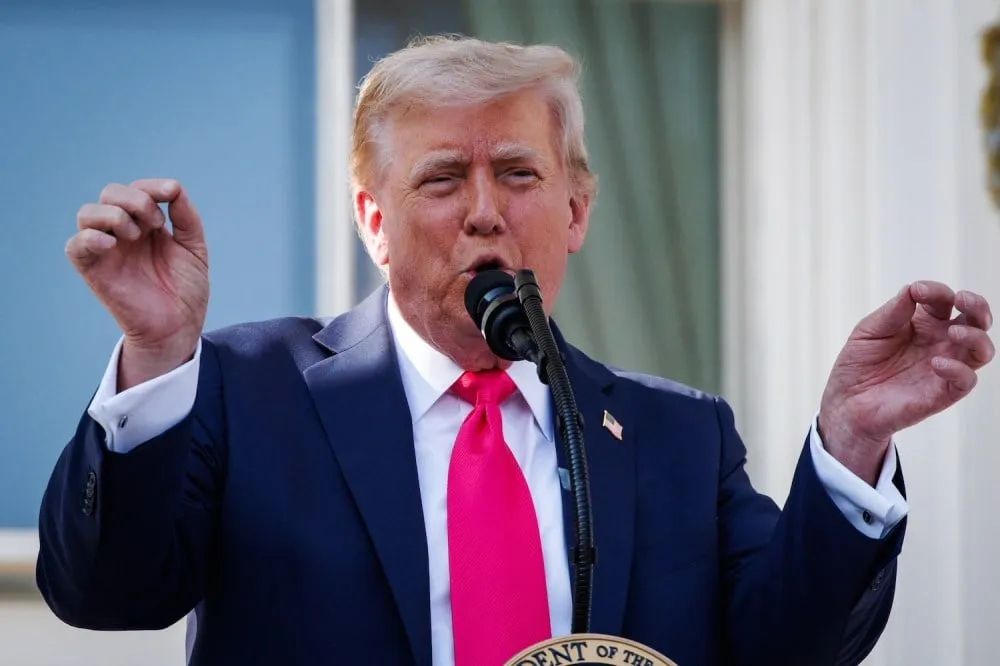The global economy is on tenterhooks as the July 9 deadline set by United States President Donald Trump for dozens of countries to reach new trade deals approaches. Failure to comply means facing sharply higher tariffs, a move that could send fresh shockwaves through international commerce. This Wednesday’s deadline follows a 90-day pause on Trump’s steepest tariffs, a temporary reprieve granted after his initial “Liberation Day” plans in April sent global markets into a tailspin.
With billions of dollars in global trade at stake, U.S. trade partners are in a frantic race against time, negotiating intensely to avoid severe damage to their economies. The uncertainty surrounding Trump’s next moves—which countries will be hit, how hard, and whether new, even higher rates could be imposed—is creating an atmosphere of anxiety across boardrooms and government ministries worldwide.
The “America First” Doctrine and the Rationale Behind Tariffs
President Donald Trump’s trade policy is fundamentally rooted in his “America First” doctrine, a nationalist approach that prioritizes domestic industries, jobs, and economic interests over multilateral trade agreements and global supply chains. This philosophy asserts that decades of free trade agreements have led to the decline of American manufacturing, job losses, and significant trade deficits, which Trump views as a sign of economic weakness and unfair practices by other nations.
Key tenets of this trade philosophy include:
- Protecting Domestic Industries: Tariffs are seen as a tool to make imported goods more expensive, thereby encouraging consumers and businesses to buy domestically produced alternatives. This is intended to stimulate local manufacturing and create jobs within the United States.
- Reducing Trade Deficits: A primary objective is to shrink the U.S. trade deficit, particularly with countries like China, by making their exports to the U.S. less competitive. Trump views large trade deficits as a drain on American wealth.
- National Security: In certain strategic sectors, tariffs are justified on national security grounds, aiming to reduce reliance on foreign suppliers for critical goods and technologies.
- Bargaining Chip: Perhaps most significantly, tariffs are employed as a powerful bargaining chip in trade negotiations. By imposing or threatening high tariffs, the Trump administration seeks to pressure trade partners into making concessions, such as reducing their own tariffs, eliminating non-tariff barriers, or agreeing to new trade deals that are perceived as more favorable to the U.S.
The “Liberation Day” plan, announced in April, initially proposed sweeping tariffs, which were then paused for 90 days. This pause was a tactical move, designed to allow time for negotiations while maintaining pressure on trade partners. However, the initial announcement alone caused significant market volatility, reflecting the global economy’s sensitivity to sudden shifts in U.S. trade policy.
A Web of Uncertainty: Conflicting Signals and Market Jitters
The lead-up to the July 9 deadline has been characterized by a confusing array of conflicting signals from the White House, adding to the jitters felt across global markets. This unpredictability is a hallmark of the Trump administration’s approach to trade, designed perhaps to keep adversaries off balance, but also creating significant challenges for businesses and governments trying to plan.
Conflicting Statements:
- Tariff Rates: On Sunday, Trump suggested that tariffs could go “as high as 70 percent,” which is even higher than the 50 percent maximum rate outlined in his original “Liberation Day” plan. This contrasts with earlier statements and adds another layer of potential severity.
- Deadline Interpretation: While Trump indicated he would begin sending letters outlining new tariff rates “this week” and conclude deals for “most countries” by Wednesday, U.S. Treasury Secretary Scott Bessent stated in an interview with CNN that tariffs for affected countries would “boomerang back” to the levels originally announced on April 2, and would be imposed “from August 1.” This discrepancy leaves businesses unsure of the exact timeline and the immediate impact.
- Deal Announcements: Trump also suggested he had “sealed a number of new trade deals” without specifying any by name, further obscuring the true extent of agreements reached.
This lack of clarity, as noted by Deborah Elms, head of trade policy at the Hinrich Foundation, makes it “harder to guess what might happen.” The strategy appears to be a blend of issuing threats of new, potentially higher rates while simultaneously hinting at possible deadline extensions for countries offering “sufficiently attractive” deals. This creates an environment where trade policy is less about predictable rules and more about dynamic, high-stakes bargaining.
Impact on Businesses and Markets: For businesses, this uncertainty translates into significant challenges:
- Supply Chain Disruptions: Companies reliant on international supply chains face difficult decisions about sourcing, production locations, and inventory management. The threat of sudden tariff hikes can force them to seek alternative suppliers or even consider reshoring production, which is costly and time-consuming.
- Investment Decisions: Businesses delay or reconsider investment plans due to the unpredictable trade environment. Long-term capital investments require a stable policy outlook, which is currently lacking.
- Increased Costs: Even if tariffs are ultimately avoided, the costs associated with contingency planning, legal advice, and potential supply chain adjustments can be substantial.
- Market Volatility: The constant stream of announcements and threats contributes to volatility in financial markets, affecting stock prices, currency exchange rates, and commodity prices.
The global economy thrives on predictability and stability. The current approach, while perhaps serving a specific political agenda, introduces an unprecedented level of risk and complexity into international trade relations.
The Scorecard: Deals Struck and Negotiations Underway
As the July 9 deadline looms, only a handful of countries have publicly announced trade deals with the U.S. that have resulted in reduced, though not eliminated, tariffs. These early agreements provide a glimpse into the types of concessions the Trump administration is seeking.
Deals Announced So Far:
- China: The U.S.-China deal saw tariffs on Chinese goods reduced from a staggering 145 percent to 30 percent, while duties on U.S. exports to China fell from 125 percent to 10 percent. However, this agreement only paused the higher tariff rates for 90 days, rather than scrapping them outright. This leaves numerous contentious issues unresolved, suggesting that the “deal” is more of a temporary truce than a comprehensive resolution to the trade imbalances. The ongoing trade tensions between the U.S. and China have been a defining feature of global economics in recent years, impacting various sectors from technology to agriculture.
- United Kingdom: The UK’s agreement resulted in it maintaining a 10 percent tariff rate. This is a relatively favorable outcome, likely reflecting the “special relationship” between the two countries and the UK’s efforts to forge new trade agreements post-Brexit.
- Vietnam: Vietnam saw its 46 percent levy replaced by a 20 percent rate on Vietnamese exports. A new 40 percent tariff was introduced for “transshipping,” a measure aimed at preventing goods from other countries (potentially China) from being routed through Vietnam to avoid U.S. tariffs. This highlights the administration’s focus on preventing circumvention of its trade measures.
Ongoing Negotiations: A host of other key U.S. trade partners have confirmed that negotiations are actively underway, indicating their serious efforts to avoid the steepest tariffs. These include:
- European Union (EU): As the U.S.’s largest trading partner, the EU’s negotiations are particularly high-stakes. DW reported that the EU was working to conclude a “skeletal” deal to defer a resolution on their most contentious differences before the deadline. This strategy aims to avoid Trump’s mooted 50 percent tariff, buying time for more comprehensive discussions later. The EU has consistently advocated for a multilateral, rules-based trading system and has expressed concerns about the unilateral imposition of tariffs.
- Canada: A close neighbor and major trading partner, Canada has been engaged in continuous discussions with the U.S. on trade matters, particularly given the integrated nature of their economies.
- India: CNBC-TV18 reported that New Delhi expected to finalize a “mini trade deal” within 24-48 hours of Sunday’s report. This agreement, citing unnamed sources, would likely see the average tariff rate set at about 10 percent. India, a rapidly growing economy, is keen to protect its export industries and maintain a stable trade relationship with the U.S.
- Japan: Al Jazeera reported that Japan has also been actively negotiating with the U.S. to safeguard its significant export-oriented industries.
- South Korea: 1News.co.nz reported that South Korea has been working to manage its trade relationship with the U.S. amidst the shifting global trade landscape.
Trump administration officials have indicated that negotiations are primarily focused on a “dozen-and-a-half countries” that make up the “vast bulk of the U.S. trade deficit.” This strategic focus underscores the administration’s primary objective of rebalancing trade flows in favor of the United States. Andrew K. McAllister, a member of Holland & Knight’s International Trade Group, suggests that while a few more deals similar to those with China, Vietnam, and the UK might be announced, most countries are likely facing “significant across-the-board tariffs.” He believes that “tariffs are here to stay,” with the bargaining chip being the level at which the tariff is set, rather than their complete removal. Countries perceived as having significant tariffs or non-tariff barriers against U.S. products are more likely to face higher levels of duties.
The BRICS Factor: Geopolitical Implications of Tariff Threats
Adding a new and significant geopolitical dimension to the trade war, President Trump on Sunday threatened to impose an “additional 10 percent tariff” on countries that align themselves with the “anti-American policies” of BRICS. This pronouncement, made on his Truth Social platform, declared, “There will be no exceptions to this policy. Thank you for your attention to this matter!”
Understanding BRICS: BRICS is an acronym for an association of major emerging economies. Originally comprising Brazil, Russia, India, China, and South Africa, the bloc has recently expanded to include new members, forming what is sometimes referred to as BRICS+. The expansion, which saw the addition of countries like Egypt, Ethiopia, Iran, Saudi Arabia, and the United Arab Emirates in January 2024, significantly broadens the bloc’s economic and geopolitical reach. BRICS aims to promote economic cooperation, development, and a more multipolar world order, often seen as an alternative to Western-dominated institutions.
Geopolitical Implications of Trump’s Threat:
- Forcing a Choice: Trump’s threat effectively attempts to force countries to choose between closer economic ties with the U.S. and alignment with the BRICS bloc. This could create significant diplomatic dilemmas for nations that seek to maintain good relations with both the U.S. and BRICS members.
- Reshaping Alliances: Such a policy could accelerate the fragmentation of the global economy into competing blocs, potentially leading to a more fractured international trade system. Countries might be compelled to re-evaluate their geopolitical alignments based on economic incentives and disincentives.
- Impact on Developing Economies: Many developing countries are members of or have strong ties with BRICS nations. Imposing additional tariffs on them could undermine their economic growth and development efforts, potentially pushing them further into the orbit of non-Western powers.
- Challenging Multilateralism: This move further undermines the principles of multilateralism and rules-based international trade, favoring bilateral leverage and political alignment over established global trade norms.
- Commodity Markets: Given that many BRICS and BRICS+ members are major commodity producers (e.g., oil, minerals), such tariffs could impact global commodity markets, leading to price volatility and supply chain shifts.
This threat represents a significant escalation in the use of trade policy as a tool for geopolitical leverage. It highlights the Trump administration’s willingness to use economic pressure to influence the foreign policy choices of other nations, potentially leading to a more confrontational and less predictable global order.
The Economic Fallout: A Global and Domestic Impact
Economists widely agree that steep tariffs imposed over a sustained period would have significant negative consequences for both the U.S. and the global economies. The impact is multifaceted, affecting prices, growth, supply chains, and consumer behavior.
Impact on the Global Economy:
- Higher Prices and Reduced Trade: Tariffs are essentially taxes on imports, which are typically passed on to consumers or absorbed by businesses, leading to higher prices. This can reduce consumer purchasing power and increase production costs for businesses, ultimately dampening global trade volumes.
- Supply Chain Restructuring: The threat of tariffs forces multinational corporations to reconsider their global supply chains. This can lead to costly and inefficient shifts, such as reshoring production (bringing it back to the home country), “friend-shoring” (sourcing from politically aligned countries), or diversifying suppliers to reduce reliance on any single nation. While these shifts can create new opportunities, they often come with increased costs and reduced efficiency in the short to medium term.
- Downgraded Economic Outlooks: Major international financial institutions have already adjusted their forecasts. The World Bank and the Organisation for Economic Co-operation and Development (OECD) last month downgraded their outlook for the global economy. The World Bank cut its forecast from 2.8 percent to 2.3 percent, and the OECD reduced its projection from 3.3 percent to 2.9 percent. These downgrades directly reflect the anticipated negative impact of trade tensions and protectionist policies on global growth.
- Reduced Global GDP: JP Morgan Research has estimated the quantitative impact of a trade war. Their analysis suggests that a 10 percent universal tariff coupled with a 110 percent tariff on China would reduce global Gross Domestic Product (GDP) by 1 percent. Even with a lower 60 percent duty on Chinese goods, the hit to global GDP would still be a significant 0.7 percent. Such reductions translate into billions of dollars in lost economic output and slower job creation worldwide.
Impact on the U.S. Economy:
- Inflationary Pressures: While initial fears of sharp price rises in the U.S. have been somewhat muted (annualized inflation came in at a modest 2.3 percent in May, close to the Federal Reserve’s target), analysts warn that inflation may still take off once businesses deplete inventory stockpiles built up in anticipation of higher costs. The time lag between tariff imposition and full price transmission to consumers can vary.
- Mixed Economic Signals: The U.S. economy presents a mixed picture. The stock market, after initial steep losses, has bounced back to an all-time high, and the economy added a stronger-than-expected 147,000 jobs in June. However, other data points to underlying jitters, such as a 0.1 percent fall in consumer spending in May, the first decline since January. Consumer spending is a critical driver of the U.S. economy, and a sustained decline would be a significant concern.
- Labor Market Dynamics: While the latest jobs report doesn’t indicate an immediate collapse in the labor market, economists caution that “this is usually the last place economic damage shows up.” The full impact on employment might only become apparent after a longer period of sustained trade tensions.
- Business Sentiment: Despite some positive economic indicators, overall business sentiment remains fragile. Uncertainty about future trade policies can lead to reduced business investment and hiring, acting as a drag on economic growth. Dutch bank ING noted, “The delay in China’s tariff levels probably came just in time to avert a more serious recessionary threat. The latest jobs report certainly doesn’t point to the bottom falling out of the labour market, though if we’re talking about time lags, this is usually the last place economic damage shows up. Sentiment remains fragile, remember.”
Specific Industry Impacts: Different sectors face varying degrees of vulnerability to tariffs:
- Manufacturing: Industries reliant on imported components or those that export heavily (e.g., automotive, electronics) are directly impacted by higher costs and reduced competitiveness.
- Agriculture: Farmers can suffer from retaliatory tariffs imposed by other countries on U.S. agricultural exports, leading to lost markets and lower prices for their produce.
- Technology: Tariffs on technology components can increase the cost of consumer electronics and hinder innovation.
- Retail: Retailers face higher sourcing costs, which they must either absorb (reducing profit margins) or pass on to consumers (potentially reducing sales).
The economic impact of a prolonged and escalating trade war would be profound, disrupting established global trade patterns, increasing costs for businesses and consumers, and ultimately slowing down global economic growth.
Historical Context and Future Scenarios
The current trade tensions, while unique in their specific dynamics, are not without historical precedent. Throughout history, nations have resorted to protectionist policies, including tariffs, often with mixed results. The Smoot-Hawley Tariff Act of 1930 in the U.S., for instance, is widely cited by economists as a contributing factor to the Great Depression, as it triggered retaliatory tariffs from other countries, severely curtailing international trade. While modern economies are more integrated and resilient, historical lessons underscore the potential for protectionism to backfire.
Future Scenarios: As the July 9 deadline approaches, several scenarios could unfold:
- Partial Agreements and Continued Bargaining: The most likely scenario is that a few more “mini deals” or “skeletal agreements” are announced, deferring the most contentious issues. This would allow the Trump administration to claim success while keeping the threat of higher tariffs alive as a bargaining tool for future negotiations. Tariffs, as McAllister suggests, may indeed “be here to stay” at some level, becoming a permanent feature of U.S. trade policy.
- Full-Blown Trade War Escalation: If a significant number of countries fail to reach agreements, or if Trump decides to impose the threatened 70% tariffs and additional BRICS-related duties, the global economy could plunge into a more severe trade war. This would lead to deeper economic contractions, increased inflation, and greater supply chain fragmentation.
- De-escalation (Less Likely in Short Term): A complete de-escalation, involving the removal of all new tariffs and a return to multilateral trade norms, appears less likely in the immediate future, given the administration’s stated philosophy and its use of tariffs as a core policy instrument.
- Impact of the U.S. Election: While not explicitly mentioned in the news content, the upcoming U.S. presidential election implicitly influences the current trade strategy. A strong stance on trade might be seen as appealing to a certain voter base, and the outcome of the election could significantly alter the long-term trajectory of U.S. trade policy.
The global trade landscape is undergoing a fundamental transformation, moving away from the predictable, rules-based system that characterized much of the post-World War II era. This shift, driven by geopolitical competition and a resurgence of economic nationalism, means that businesses and governments must adapt to a new reality of higher uncertainty and increased friction in international commerce.
Featured ESG Tool of the Week:
Klimado – Navigating climate complexity just got easier. Klimado offers a user-friendly platform for tracking local and global environmental shifts, making it an essential tool for climate-aware individuals and organizations. In an era where climate data can be overwhelming, Klimado provides clarity and actionable insights, empowering users to make informed decisions for a more sustainable future.
Conclusion
The impending July 9 tariff deadline represents a moment of intense anticipation for the global economy. While the Trump administration’s trade strategy aims to rebalance trade flows and protect domestic industries, its unpredictable nature and the threat of escalating tariffs are generating significant uncertainty and potential economic fallout. The limited number of comprehensive deals struck so far, coupled with the new geopolitical dimension introduced by the BRICS threat, suggests that tariffs are likely to remain a prominent feature of global trade. As businesses and governments brace for the potential impact, the coming days will be crucial in shaping the immediate future of international commerce, with long-term implications for global supply chains, economic growth, and geopolitical alignments.
Photo source: Google
By: Montel Kamau
Serrari Financial Analyst
8th July, 2025
Article, Financial and News Disclaimer
The Value of a Financial Advisor
While this article offers valuable insights, it is essential to recognize that personal finance can be highly complex and unique to each individual. A financial advisor provides professional expertise and personalized guidance to help you make well-informed decisions tailored to your specific circumstances and goals.
Beyond offering knowledge, a financial advisor serves as a trusted partner to help you stay disciplined, avoid common pitfalls, and remain focused on your long-term objectives. Their perspective and experience can complement your own efforts, enhancing your financial well-being and ensuring a more confident approach to managing your finances.
Disclaimer: This article is for informational purposes only and does not constitute financial advice. Readers are encouraged to consult a licensed financial advisor to obtain guidance specific to their financial situation.
Article and News Disclaimer
The information provided on www.serrarigroup.com is for general informational purposes only. While we strive to keep the information up to date and accurate, we make no representations or warranties of any kind, express or implied, about the completeness, accuracy, reliability, suitability, or availability with respect to the website or the information, products, services, or related graphics contained on the website for any purpose. Any reliance you place on such information is therefore strictly at your own risk.
www.serrarigroup.com is not responsible for any errors or omissions, or for the results obtained from the use of this information. All information on the website is provided on an as-is basis, with no guarantee of completeness, accuracy, timeliness, or of the results obtained from the use of this information, and without warranty of any kind, express or implied, including but not limited to warranties of performance, merchantability, and fitness for a particular purpose.
In no event will www.serrarigroup.com be liable to you or anyone else for any decision made or action taken in reliance on the information provided on the website or for any consequential, special, or similar damages, even if advised of the possibility of such damages.
The articles, news, and information presented on www.serrarigroup.com reflect the opinions of the respective authors and contributors and do not necessarily represent the views of the website or its management. Any views or opinions expressed are solely those of the individual authors and do not represent the website's views or opinions as a whole.
The content on www.serrarigroup.com may include links to external websites, which are provided for convenience and informational purposes only. We have no control over the nature, content, and availability of those sites. The inclusion of any links does not necessarily imply a recommendation or endorsement of the views expressed within them.
Every effort is made to keep the website up and running smoothly. However, www.serrarigroup.com takes no responsibility for, and will not be liable for, the website being temporarily unavailable due to technical issues beyond our control.
Please note that laws, regulations, and information can change rapidly, and we advise you to conduct further research and seek professional advice when necessary.
By using www.serrarigroup.com, you agree to this disclaimer and its terms. If you do not agree with this disclaimer, please do not use the website.
www.serrarigroup.com, reserves the right to update, modify, or remove any part of this disclaimer without prior notice. It is your responsibility to review this disclaimer periodically for changes.
Serrari Group 2025












